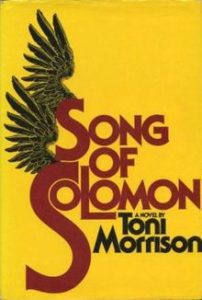
Six Novels That Capture Detroit, Past and Present
Jodie Adams Kirshner on Toni Morrison, Joyce Carol Oates, Jeffrey Eugenides, and More
As I spent several years in Detroit following a small group of residents in the aftermath of their city’s bankruptcy to write my book Broke: Hardship and Resilience in a City of Broken Promises, I felt the city’s atmosphere seeping into my very bones. Today’s Detroit is luxury watch stores, and galleries, and organic bakeries. It’s commercial strips with the vestiges of long-shuttered businesses, and residential streets filled with burned houses, vacant lots, and trash. It’s a summer quiet so deep one can hear the buzzing of cicadas. It’s a lone bicycle gliding down a deserted six-lane road. It’s Tudor and Colonial mansions, some with turrets and spires, and old municipal electric boxes that look like churches. It’s new garden plots, and pocket parks, and children’s’ laughter from tire swings, and boarded windows painted with colorful suns and palm trees. It’s a formerly abandoned house converted into a community bulletin board, and other neighborhoods where no one sits on stoops, no children play outside, and no noise accumulates.
One can find Detroit in the man using a propane tank to cook in the unheated family home that no longer belongs to him, the people walking in the street to avoid cracked sidewalks, the child ordering an ice cream cone through bullet-proof glass, and churches advertising emergency water hotlines. One can see the city reflected in blue-tarped roofs, and empty lots pregnant with possibilities, some planted with wildflower gardens or converting into meadows. And it’s also there in the glittering new stadiums, the sleek downtown restaurants, and the renovating art deco skyscrapers.
As artists flee a condemned old auto body factory, a state-of-the-art light rail line travels three-and-a-half miles, bordered by museums. Schools in new buildings are slated for closure, and a woman mows her entire block, her long braid trailing behind her. A storefront painted with multicolored farmyard scenes, sitting next to a boarded-up liquor store missing half its roof, hosts a farmers’ market in the front parking lot. The Mayor cuts a ribbon at a ceremony for a rehabilitated Midtown apartment building, as another house nearby bursts into flames. A little girl plays in a collapsing house, as young, educated professionals commute from glass condominiums downtown to a renovated Model T showroom with solar panels dotting the roof. A car sits in freeway traffic with its radio bumping, and a train station becomes a hub for the future of mobility. Abandoned houses are repurposed as art projects, and abandoned manufacturing buildings reopen as social clubs and creative firms.
At times today’s Detroit seems to exist in the shadow of the city that it used to be. Detroit has a gripping history that permeates its remaining streetscapes—a story about American industrial might, war victories, grit, and resilience. People still talk about what no longer exists. They speak of the buzz of shopping at Hudson’s department store or strolling down tree-lined avenues. They remember how the assembly lines once offered opportunities, even as robots now man the lines, in the few factories that continue to run at all.
The Detroit of right now and the Detroit I arrived too late to see coexist in its literature, which reflects how the city is evolving and changing. The following six novels set in Detroit, listed in reverse chronological order, capture the feeling of the city’s present and past.

Stephen Mack Jones, August Snow
In this classic noir detective mystery, a mixed-race, former Detroit cop flush with settlement money from a wrongful dismissal suit against the city returns to his childhood home and begins to investigate a crime, as he simultaneously tries to turn around his neighborhood. The Detroit setting distinguishes the book from other examples of the genre. In Mack Jones’s writing, the city becomes a character of its own. His portrayal of the Mexicantown neighborhood—its restaurants and its long-time residents—brings to life the vitality and pride simmering in so many of the city’s neighborhoods, and his detective acts at the intersection of the city’s politics, culture, and history. Though the plot veers towards the ridiculous, involving international money laundering and assassins, the book provides a fun and educational read.

Angela Flournoy, The Turner House
Another recent debut novel, The Turner House, charts the lives of a family of thirteen siblings as they determine what to do with their family house on Detroit’s eastside. The book offers a slow-paced, character-driven exploration of complex family relationships, but, as in August Snow, the city itself becomes a force driving events. The book vividly describes the family’s earlier migration to the city to escape the Jim Crow South, only to encounter housing and job discrimination there. In the aftermath of the recent financial crisis, the family must now navigate the city’s poverty and housing challenges. The family house has fallen to one tenth the value of its mortgage, and the garage is stolen for scrap metal.

Jeffrey Eugenides, The Virgin Suicides
Eugenides grew up in Detroit, and The Virgin Suicides is the first book he wrote that takes place there. Middlesex followed. The Virgin Suicides carries its readers to the affluent suburb of Grosse Pointe. There, a group of teenage boys experience a rapid succession of suicides by five sisters they loved, and later, as adults, seek to understand the deaths. Suicide in Eugenides’ depiction becomes both abstract and routine. The melancholy of the suburban dream that ravaged the city is similarly brought to life. As the book provides a study of how men look at women, it also provides a detailed look at the leafy areas surrounding Detroit in the 1970s.

Toni Morrison, Song of Solomon
Arguably one of the most important works of fiction, Song of Solomon resists short summarizing. But the memorable first half of this coming-of-age novel, Toni Morrison’s third book, is set in an unnamed rustbelt city presumed to be Detroit. There, Milkman begins a search for his heritage that takes him on a journey to the South and toward embracing his origins. The book offers a complex, layered observation of family and community that is highly atmospheric, and larded with the poetic rhythms of vernacular speech and the dream-like visions of magical realism.

Joyce Carol Oates, them
them traces the experiences of a multigenerational white family fighting against poverty. Their striving occurs against the backdrop of Detroit between 1937 and 1967 and ends in the race riots. Oates based the book on the life of one of her students, who wrote to her after she gave the student a failing grade in a college class. The novel interlaces descriptions of life in the city with the dreams and fates of its characters. The aspirations and struggles of those individuals raise much larger social issues, and the book makes palpable the forces that keep a family down.

Harriette Arnow, The Dollmaker
Set during World War II, The Dollmaker follows events in the life of a fearless, uneducated young mother of five. She moves with her family from the Kentucky hills to industrial Detroit, where her husband has work in a factory. Though the city is in its heyday, she nevertheless struggles to adapt, and even to survive, in the city’s alien environment. Far from nature, she accumulates debt buying on credit. Ultimately, the book explores how she and her family are changed by Detroit.
__________________________________

Jodie Adams Kirshner’s Broke: Hardship and Resilience in a City of Broken Promises is out now from St. Martin’s.
Jodie Adams Kirshner
Jodie Adams Kirshner is a research professor at New York University. Previously on the law faculty at Cambridge University, she also teaches bankruptcy law at Columbia Law School. She is a member of the American Law Institute, past term member of the Council on Foreign Relations, and technical advisor to the Bank for International Settlements. She received a prestigious multi-year grant from the Kresge Foundation to research this book.



















